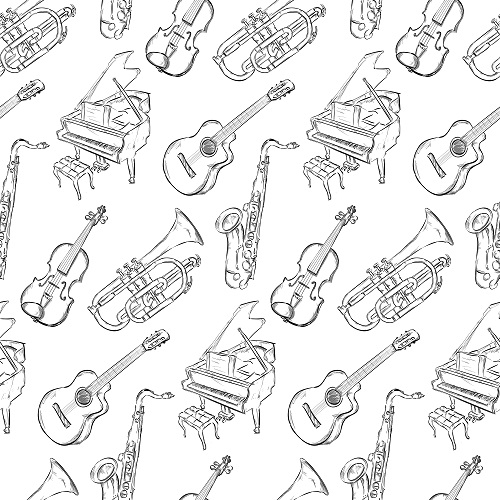Music Theory Basics Part 2
Ok! So now that we understand Scales, let’s talk about Chords. Chords are 3 or more notes played simultaneously. The two most common 3 note chords (a Triad) are called Major and Minor. Though used less often, we’ll also talk about Diminished (Dim) and Augmented (Aug) triads.
Once you know the major scale of a given key, it’s easy to figure out the chords built from its Root (first note of the scale). We just assign numbers to each note of the scale, and use these simple formulas:
Major – 1 3 5
Minor – 1 b3 5
Dim – 1 b3 b5
Aug – 1 3 #5
So, using the key of C (C, D, E, F, G, A, B, C) we come up with:
Major – C E G
Minor – C Eb G
Dim – C Eb Gb
Aug – C E G#
So what about chords with more than 3 notes? The most common 4 note chords are 7, Minor 7, Major 7, Half-Diminished 7, and Diminished 7. Here are the corresponding formulas:
7 – 1 3 5 b7
Minor 7 – 1 b3 5 b7
Major 7 – 1 3 5 7
Half-Dim 7 – 1 b3 b5 b7
Dim 7 – 1 b3 b5 bb7
You’ll notice that Diminished 7 has a double flatted 7. Don’t be alarmed if you end up with a double flatted note! One good example is C Diminished 7 – C, Eb, Gb, and Bbb. While Bbb sounds the same as A, we still call it Bbb so it’s a 7th as opposed to a 6 (we’ll talk about 6 chords in a bit).
Keep in mind that any chord can include Octaves! Octave comes from the prefix Oct, or 8. The 8th note of the scale, which is the same letter as the first note! Guitar and Piano voicings usually use Octaves to create a wider, bigger sound. Orchestras, with so many instruments, often use many octaves between all the parts!
Everything Else!
Figuring out other chords is pretty simple once you understand the above, and learn a few simple rules!
A “slash” chord (/) is what we call an Inversion – a note other than the root is the lowest. The upper notes can be in any order.
C/E – E, G, C or E, C, G
C/G – G, C, E or G, E, C
Suspended (Sus) chords “suspend” the 3rd up to the 4th. These can be called either Sus or Sus 4. Sometimes we see Sus 2 Chords – on these we suspend the 3 down to the 2. A Sus 7 includes the b7 in the Sus chord.
Sus (4) – 1 4 5
Sus 2 – 1 2 5
Sus 7 – 1 4 5 b7
The fifth can be altered on some 7th Chords for some more exotic sounds:
7b5 – 1 3 b5 b7
7#5 (Aug7) -1 3 #5 b7
Major 7 b5 – 1 3 b5 7
Major 7 #5 – 1 3 #5 7
6 Chords just add the 6 to the Major or Minor chord:
6 (Major 6) – 1 3 5 6
Minor 6 – 1 b3 5 6
Extensions
Extensions are when we add notes beyond the 7th – either the 9th, 11th, or 13th. While these notes would be the same as the 2nd, 4th, and 6th degrees of the key, all extended chords include the basic 7 chord it is built off in addition to the 9th, 11th, or 13th. 13th chords can include the 9th and the 11th, and 11th chords can include the 9th, but only one extension is necessary. Also… unless the 5th of the chord is flat or sharp, it can be dropped (common for guitar chord voicings as we only have 6 strings and 4 fingers!)
So… here’s how we’d build a C13 chord:
13 – 1 3 5 b7 9 11 13
C 13 – C E G Bb D F A
We could use only C, E, Bb, and A, and we would still call it a 13 chord. However the 9 is quite common, while the 11th can be used but is often dropped as it’s quite dissonant. The 5 is optional, but is usually present.
You might also see b9, #9, #11, and b13. These are exactly what you think they are – voice the full chord as above, then alter specified note(s), just as you would with b5 and #5 chords.
Shorthand
Lastly, be aware of some shorthand that composers use when writing chords!
Major 7 – M7, Maj7, △7
Minor 7 – m7, min7, -7
Augmented – aug, #5, +
Diminished – dim, b5, O
Diminished 7 – dim7, O7
Half Diminished 7 – half dim, m7b5, ø7
b9, #9, b5, #5 – alt
Try your hand at the worksheet below! Please email your answers to [email protected] and I’ll be happy to grade it for you!

